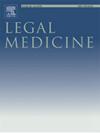Intraoral gunshot injury associated with soot in the deep airways
IF 1.3
4区 医学
Q3 MEDICINE, LEGAL
引用次数: 0
Abstract
In suicidal gunshots to the head, the oral cavity ranks among the preferred entrance sites. If the weapon’s muzzle end is located within the mouth, it is to be expected that the cartridge discharge residues are deposited on the buccal and palatal mucosa, the tongue and the pharynx, often in combination with tears of the lips due to the expanding combustion gases. Ensuing from the bullet entrance wound and any concomitant injuries, blood is released into the upper airways and subsequently aspirated into the lung periphery provided that respiration continues for at least a short time. Evidently, this impedes the detection of additional soot deposits in the trachea, bronchi and alveoli. Using the example of an intraoral gunshot with a revolver cal. 357 Magnum, the paper points out that in individual cases it may be possible to prove the presence of gunshot residues in the deep airways.
口内枪伤与深呼吸道烟灰有关
在头部自杀性枪击中,口腔是首选的入口部位之一。如果武器的枪口位于口腔内,预计弹壳排出的残留物会沉积在颊粘膜、腭粘膜、舌和咽部,通常还会因燃烧气体膨胀而导致嘴唇撕裂。子弹入口处的伤口和任何伴随的损伤都会导致血液排入上呼吸道,随后吸入肺部周围,前提是呼吸至少要持续很短的时间。显然,这阻碍了对气管、支气管和肺泡中其他烟尘沉积物的检测。论文以 357 口径马格南左轮手枪口内枪击为例,指出在个别情况下,有可能证明深呼吸道中存在枪击残留物。
本文章由计算机程序翻译,如有差异,请以英文原文为准。
求助全文
约1分钟内获得全文
求助全文
来源期刊

Legal Medicine
Nursing-Issues, Ethics and Legal Aspects
CiteScore
2.80
自引率
6.70%
发文量
119
审稿时长
7.9 weeks
期刊介绍:
Legal Medicine provides an international forum for the publication of original articles, reviews and correspondence on subjects that cover practical and theoretical areas of interest relating to the wide range of legal medicine.
Subjects covered include forensic pathology, toxicology, odontology, anthropology, criminalistics, immunochemistry, hemogenetics and forensic aspects of biological science with emphasis on DNA analysis and molecular biology. Submissions dealing with medicolegal problems such as malpractice, insurance, child abuse or ethics in medical practice are also acceptable.
 求助内容:
求助内容: 应助结果提醒方式:
应助结果提醒方式:


